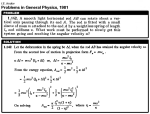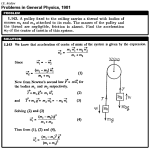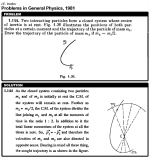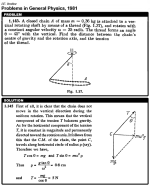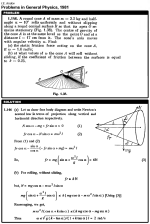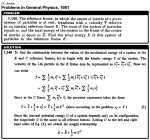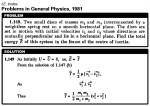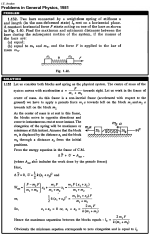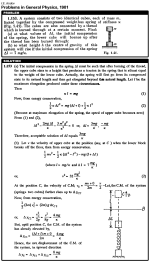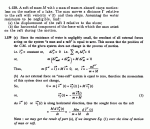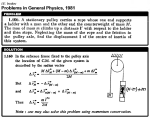| № |
Condition |
free/or 0.5$ |
| 141 | A horizontal plane supports a plank with a bar of mass m = 1.0 kg placed on it and attached by a light elastic non-deformed cord of length l0 = 40 cm to a point O (Fig,. 1.35). The coefficient of friction between the bar and the plank equals k = 0.20. The plank is slowly shifted to the right until the bar starts sliding over it. It occurs at the moment when the cord deviates from the vertical by an angle θ = 30°. Find the work that has been performed by that moment by the friction force acting on the bar in the reference frame fixed to the plane. |
|
| 142 | A smooth light horizontal rod AB can rotate about a vertical axis passing through its end A. The rod is fitted with a small sleeve of mass m attached to the end A by a weightless spring of length l0 and stiffness χ. What work must be performed to slowly get this system going and reaching the angular velocity ω? |
|
| 143 | A pulley fixed to the ceiling carries a thread with bodies of masses m1 and m2 attached to its ends. The masses of the pulley and the thread are negligible, friction is absent. Find the acceleration wC of the centre of inertia of this system. |
|
| 144 | Two interacting particles form a closed system whose centre of inertia is at rest. Fig. 1.36 illustrates the positions of both par-ticles at a certain moment and the trajectory of the particle of mass Draw the trajectory of the particle of mass m2 if m2 = m1/2. |
|
| 145 | A closed chain A of mass m = 0.36 kg is attached to a vertical rotating shaft by means of a thread (Fig. 1.37), and rotates with a constant angular velocity ω = 35 rad/s. The thread forms an angle θ = 45° with the vertical. Find the distance between the chain s centre of gravity and the rotation axis, and the tension of the thread. |
|
| 146 | A round cone A of mass m = 3.2 kg and half angle a = 10° rolls uniformly and without slipping along a round conical surface B so that its apex O remains stationary (Fig. 1.38). The centre of gravity of the cone A is at the same level as the point 0 and at a distance L = 17 cm from it. The cone s axis moves with angular velocity w. Find: (a) the static friction force acting on the cone A, if w = 1.0 rad/s; (b) at what values of co the cone A will roll without sliding, if the coefficient of friction between the surfaces is equal to k = 0.25. |
|
| 147 | In the reference frame K two particles travel along the x axis, one of mass m1 with velocity v1 and the other of mass m2 with velocity v2. Find: (a) the velocity V of the reference frame K* in which the cumulative kinetic energy of these particles is minimum; (b) the cumulative kinetic energy of these particles in the K* frame. |
|
| 148 | The reference frame, in which the centre of inertia of a given system of particles is at rest, translates with a velocity V relative to an inertial reference frame K. The mass of the system of particles equals m, and the total energy of the system in the frame of the centre of inertia is equal to E1. Find the total energy E of this system of particles in the reference frame K. |
|
| 149 | Two small discs of masses m1 and m2 interconnected by a weightless spring rest on a smooth horizontal plane. The discs are set in motion with initial velocities v1 and v2 whose directions are mutually perpendicular and lie in a horizontal plane. Find the total energy E of this system in the frame of the centre of inertia. |
|
| 150 | A system consists of two small spheres of masses m1 and m2 interconnected by a weightless spring. At the moment t = 0 the spheres are set in motion with the initial velocities v1 and v2 after which the system starts moving in the Earth s uniform gravitational field. Neglecting the air drag, find the time dependence of the total momentum of this system in the process of motion and of the radius vector of its centre of inertia relative to the initial position of the centre. |
|
| 151 | Two bars of masses m1 and m2 connected by a weightless spring of stiffness χ (Fig. 1.39) rest on a smooth horizontal plane. Bar 2 is shifted a small distance x to the left and then released. Find the velocity of the centre of inertia of the system after bar 1 breaks off the wall. |
|
| 152 | Two bars connected by a weightless spring of stiffness x and length (in the non-deformed state) L0 rest on a horizontal plane. A constant horizontal force F starts acting on one of the bars as shown in Fig. 1.40. Find the maximum and minimum distances between the bars during the subsequent motion of the system, if the masses of the bars are: (a) equal; (b) equal to m1 and m2 , and the force F is applied to the bar of mass m2 . |
|
| 153 | A system consists of two identical cubes, each of mass m, linked together by the compressed weightless spring of stiffness χ (Fig. 1.41). The cubes are also connected by a thread which is burned through at a certain moment. Find: (a) at what values of Δl, the initial compression of the spring, the lower cube will bounce up after the thread has been burned through; (b) to what height h the centre of gravity of this system will rise if the initial compression of the spring Δl = 7 mg/χ. |
|
| 154 | Two identical buggies 1 and 2 with one man in each move without friction due to inertia along the parallel rails toward each other. When the buggies get opposite each other, the men exchange their places by jumping in the direction perpendicular to the motion direction. As a consequence, buggy 1 stops and buggy 2 keeps moving in the same direction, with its velocity becoming equal to v. Find the initial velocities of the buggies v1 and v2 if the mass of each buggy (without a man) equals M and the mass of each man m. |
|
| 155 | Two identical buggies move one after the other due to inertia (without friction) with the same velocity v0. A man of mass m rides the rear buggy. At a certain moment the man jumps into the front buggy with a velocity u relative to his buggy. Knowing that the mass of each buggy is equal to M, find the velocities with which the buggies will move after that. |
|
| 156 | Two men, each of mass m, stand on the edge of a stationary buggy of mass M. Assuming the friction to be negligible, find the velocity of the buggy after both men jump off with the same horizontal velocity u relative to the buggy: (1) simultaneously; (2) one after the other. In what case will the velocity of the buggy be greater and how many times? |
|
| 157 | A chain hangs on a thread and touches the surface of a table by its lower end. Show that after the thread has been burned through, the force exerted on the table by the falling part of the chain at any moment is twice as great as the force of pressure exerted by the part already resting on the table. |
|
| 158 | A steel ball of mass m = 50 g falls from the height h=1.0 m on the horizontal surface of a massive slab. Find the cumulative momentum that the ball imparts to the slab after numerous bounces, if every impact decreases the velocity of the ball n = 1.25 times. |
|
| 159 | A raft of mass M with a man of mass m aboard stays motionless on the surface of a lake. The man moves a distance L* relative to the raft with velocity v*(t) and then stops. Assuming the water resistance to be negligible, find: (a) the displacement of the raft 1 relative to the shore; (b) the horizontal component of the force with which the man acted on the raft during the motion. |
|
| 160 | A stationary pulley carries a rope whose one end supports a ladder with a man and the other end the counterweight of mass M. The man of mass m climbs up a distance L* with respect to the ladder and then stops. Neglecting the mass of the rope and the friction in the pulley axle, find the displacement L of the centre of inertia of this system. |
|

